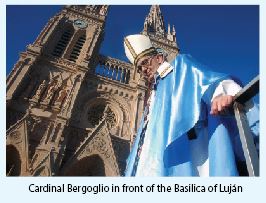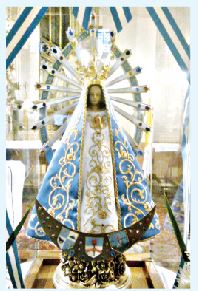 Habemus Papam! We have a Pope! These were the words that resounded from the balcony of St. Peter’s Basilica on the evening of March 13th, 2013 in Rome. The eyes of the world had been fixed on the “chimney”, awaiting the white smoke that would indicate the choice of a new Pope for the Roman Catholic Church. Many were surprised but quickly reassured as he made his appearance as Pope Francis and asked the people gathered in St. Peter’s square, as well as those watching through the media all over the world, to pray to Our Lord, imploring His blessing upon him as the new Vicar of Christ. As he humbly bowed before them, there was complete silence in the crowd. Everyone present closed their eyes and bowed their heads to pray for the new Pontiff, thanking God for this man who had instantly won their hearts as well as the hearts of all those throughout the whole world who were watching at that moment…
Habemus Papam! We have a Pope! These were the words that resounded from the balcony of St. Peter’s Basilica on the evening of March 13th, 2013 in Rome. The eyes of the world had been fixed on the “chimney”, awaiting the white smoke that would indicate the choice of a new Pope for the Roman Catholic Church. Many were surprised but quickly reassured as he made his appearance as Pope Francis and asked the people gathered in St. Peter’s square, as well as those watching through the media all over the world, to pray to Our Lord, imploring His blessing upon him as the new Vicar of Christ. As he humbly bowed before them, there was complete silence in the crowd. Everyone present closed their eyes and bowed their heads to pray for the new Pontiff, thanking God for this man who had instantly won their hearts as well as the hearts of all those throughout the whole world who were watching at that moment…
“Mother may your gaze renew our hope.” (Words of Card. Bergoglio, now Pope Francis, at the Shrine of Our Lady of Luján, Buenos Aires, Argentina, Oct. 6, 2009.)
Pope Francis was born Jorge Mario Bergoglio in Buenos Aires, Argentina, home to the National Basilica of Our Lady of Luján, Patroness of Argentina. The people of Argentina, wishing to recognize the great devotion and love that their beloved former Cardinal, now Pope, has for Our Lady of Luján, are presently having a special chalice created for him by the famous Argentinean goldsmith Juan Carlos Pallarols. Pallarols, who likes to involve the public in his creations, has invited the multitudes to “chisel their mark” in this special chalice, as it passes through each diocese, giving everyone an opportunity to “personalize” this special gift which will then be presented to the Pope from the people of his country. Featured on one side of the chalice will be the image of Our Lady of Luján, and on the other side, Mary Untier of Knots, a devotion which Pope Francis himself became acquainted with while still a young priest studying Theology in Germany. He then purchased a replica of the famous painting and brought it back to Argentina, to introduce and personally promote this devotion amongst the people.
The history of the small statue of Our Lady of Luján or as she is known to the people of Argentina, Nuestra Señora de Luján, which is enshrined in the Basilica of Luján, is a very remarkable one. In the year 1630 a Portuguese farmer, Antonio Farlas, came to establish himself in the small village of Sumampa (Santiago del Estero), in the Province of Cordova in Argentina. He was saddened when he realized that his neighbors did not share his faith in God and there was no chapel or even a small shrine in which to visit and pray to the Mother of God. He decided to write a letter to a friend in Brazil, asking him to send him a statue of the Blessed Mother. Not knowing which Virgin to choose, his friend sent him two small statues both made of terra cotta, - one of the Virgin with the Child Jesus and the second of the Immaculate Conception. (Note – this was long before the official proclamation of the Dogma by Pius IX (1854) on the Immaculate Conception.) He had them first delivered by boat across the sea, then loaded onto a cart to be carried inland to Sumampa.
 It would seem that the Portuguese settler was merely an instrument of God who, through his pious determination, had served to bring about an even greater good. The small statue of the Blessed Mother with the Child Jesus did finally reach its destination, travelling over 1150 km (almost 715 miles). It was enshrined and became the object of veneration to the local people under the title of Our Lady of Consolation. However, the little statue of the Immaculate Conception would never reach Cordova…
It would seem that the Portuguese settler was merely an instrument of God who, through his pious determination, had served to bring about an even greater good. The small statue of the Blessed Mother with the Child Jesus did finally reach its destination, travelling over 1150 km (almost 715 miles). It was enshrined and became the object of veneration to the local people under the title of Our Lady of Consolation. However, the little statue of the Immaculate Conception would never reach Cordova…
The small caravan of carts pulled by horses and oxen left Buenos Aires and travelled for about a day, stopping at the ranch of Don Rosendo for the night. The group was all set to leave early the next morning but the oxen pulling the cart that contained the statue of the Immaculate Conception refused to advance. The men tried everything to get the animals to cooperate; they even added extra oxen to help with the pulling, but still to no avail. Then they decided to unload some of the boxes thinking that the animals might be tired. It was only after the box containing the statue was unloaded that the animals finally began to move forward. If the statue was reloaded onto the cart, the animals would once again refuse to move. After many attempts, the men finally understood that something miraculous was happening-the Blessed Mother did not want to leave this place.
It was determined that the statue would have to be left behind, so it was given to Don Rosendo, whose family was overjoyed to welcome Her into their home. There was a young black slave named Manuel who was among those travelling in the caravan. He had been brought from Angola in Africa when he was very young and had been sold as a slave in Brazil. He was 8 years old at the time of the miracle and he begged to be left behind to look after the little statue of the Virgin. Don Rosendo made the arrangements with his owner and Manuel had the joy of sharing the same room with the miraculous statue in the Rosendo home. Manuel made it his own personal mission to devote his life to the care and devotion of this image. He also devoted much time to those in need, especially caring for the sick. Some say he even performed miraculous cures with the wax from the candles that burned before the image.
News of the arrival of Our Lady’s statue and the miraculous way in which She had chosen to remain in this region spread far and wide among the people. Pilgrims began to flock in large numbers to the Rosendo home and it soon became evident that the little house was too small to accommodate so many visitors. Encouraged by Manuel, Don Rosendo built a small chapel in the grasslands where the Virgin could be kept and venerated and Manuel became Her full time sacristan. After the death of Don Rosendo, the place became almost completely deserted, but Manuel still remained faithfully at his task. In 1674, Dona Ana de Mattos, a wealthy widow of the region who owned much land, went to see Fr. Juan de Oramas, administrator for the estate of Don Rosendo and obtained from him the permission to remove the statue from the primitive little chapel. She had it placed in a chapel in her own home for veneration, but a strange thing happened… Despite the fact that the chapel was locked up for the night, it was discovered in the morning that the little statue had disappeared! It was later found in its original place back at the little wooden chapel on Don Rosendo’s land! When Dona Ana brought the statue into her home a second time, placing someone at the entrance of the chapel to guard it during the night, the same thing happened; the statue mysteriously returned to the little wooden chapel!
After consulting the Bishop, it was decided that the statue should be brought in a solemn procession from the Rosendo’s ranch to Dona Ana’s chapel. The people of the region accompanied Her, and leading the procession was the humble Manuel, faithful servant to Our Lady. This was now the third attempt to install Our Blessed Mother’s statue in the de Mattos chapel. This time though, Manuel would be officially named as her personal caretaker. With Her favorite sacristan to care for Her, Our Lady was obviously happy, and she chose to remain in Dona Ana’s chapel. Manuel continued his labor of love, caring for the little statue and the chapel, and visiting the poor and the sick. One day Our Blessed Mother spoke to Manuel, telling him on what day he was going to die and promising that he would come to Heaven. He died a very holy death on the date that She had predicted and was buried in a tomb at the foot of the altar where Our Lady is enshrined.
Our Lady of Luján, the beloved Nuestra Señora of the Argentinean people stands only about twenty inches high. Her face is dark and oval shaped; her blue eyes are wide and open and gaze into the distance. She is surrounded by a golden aureole and clothed in a mantle of light blue with a white dress, the colors of the flag of Argentina. On her head she wears a gemmed crown with over 350 diamonds, sapphires, rubies and about 130 pearls, a gift from Fr. Jorge Maria Salvaire, a Lazarist missionary who had been rescued from being executed by his indigenous captives, through the intercession of Our Lady of Lujan. Pope Leo XIII blessed this crown, and a solemn coronation of the statue took place on May 8th, 1887, only eight days before the first stone was laid to begin the building of the present day basilica (granted this title by Pope Pius XII on December 8th, 1930). Miracles of cures and conversions continue to take place to this day, as Our Blessed Mother continues to welcome Her children from every part of the globe.
We thank you, Dear Lady of Luján, Mother of the Poor and the Humble, for your gift of Pope Francis to the world as Vicar of Your Son’s Church. Please grant him the strength and the courage to faithfully lead the Barque of Peter in these difficult times that we live. May he live that spirit of his holy patron, St. Francis, to “…serve the poorest, the weakest, the least important.”